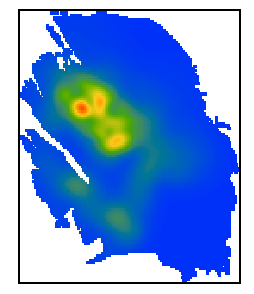The mission of the Stochastic Operations Research group (SOR) is to conduct mathematical education and research of internationally high standards in the areas of stochastic processes and mathematics of operations research, to contribute to the development of mathematics in a multidisciplinary engineering environment, and contribute to a better understanding and functioning of our increasingly complex society.
Operations Research aims at the development of mathematical models and methods for the design, control and optimisation of complex systems. Within this broad field, SOR focuses on mathematical challenges in the area of stochastic processes, and its engineering environment in societally relevant areas. Operations Research techniques focus on improving efficiency, but at the same time improved efficiency often leads to increased job satisfaction: experienced work load is dominated by those moments at which the work pressure is very high. Improved efficiency may also improve safety since errors due to peak workload may be avoided.
The fundamental mathematical areas of expertise of SOR include probability theory, with emphasis on stochastic processes. The bridge to engineering applications is established through areas of expertise that include the theory of games, stochastic dynamic programming, queues, polling systems, large deviations and discrete event simulation. Typical application areas are in health care (patient logistics, treatment and diagnostics planning, medication), transportation and production & logistics (facility location, supply chains, production systems, inventory management, road traffic).
Health care logistics

Health care expenditures in the Netherlands may increase from roughly 10% of GDP in 2010 to roughly 20% in 2035. This increase is, to a large extent, due to our ageing population, in which the percentage of people over 65 will increase from roughly 15% to roughly 25% in the same period. Sustaining the current quality of care seems to require a rapidly increasing percentage of the work force to be employed in the health care sector, while there already is a shortage in health care staff. Typical challenges include efficient planning of operating theatres, balancing the number of patients in wards to reduce peaks and therefore increase the efficiency of nursing care, efficient rostering of staff to allow for more work to be done by the same number of people. Addressing these challenges requires a broad spectrum of techniques from Operations Research, including queueing theory, dynamic programming, game theory, discrete event simulation, discrete optimisation, mathematical programming and scheduling.
Employing Operations Research techniques seems to be dedicated to improving efficiency, at the same time improved efficiency leads to increased job satisfaction as experienced work load is often dominated by those moments at which the work pressure is very high, and it also improves patient safety since errors due to peak work load will be avoided. Health care is in dire straits. Fortunately, more and more health care organizations are realizing that Operations Research may provide an approach to sustain our health care system. Such an approach requires close collaboration between Operations Research specialists and health care professionals to tackle resource optimization challenges of the health care sector and implement their solutions in health care organisations.
Research in healthcare is concentrated in the Center for Healthcare Operations Improvement and Research (CHOIR), see our brochure or www.utwente.nl/choir. Implementation of the results is, in part, carried out via our spin-off Rhythm bv., see www.rhythm.nl.
Spatial Stochastics
 Today, much information reaches us in graphical form. Such data may be divided into various classes, each having its own salient characteristics.
Today, much information reaches us in graphical form. Such data may be divided into various classes, each having its own salient characteristics.
For instance, in classical geostatistics, some spatially varying variable is observed at a given number of fixed locations, and one is interested in its value at locations where it was not observed. One might think of the prediction of ore content in the soil based on measurements at some conveniently placed boreholes or the construction of air pollution maps based on gauge data. In other cases, due to technical constraints or for privacy reasons, data is collected in aggregated form as region counts or as a discrete image. Typical examples include satellite imagery, tomographic scans, disease maps, or yields in agricultural field trials.
In this case, the objective is often spatial smoothing or sharpening rather than prediction. Data may also consist of a set of objects or phenomena tied to random spatial locations, and the prime interest is in the geometrical arrangement of the set, for instance, in the study of earthquakes or of cellular patterns seen under a microscope.
At SOR, we specialize in the probabilistic modeling of complex geometrical structures, including point and object processes, random fields, tessellations, and networks. We also develop statistical inference tools and recently started a research line in spatio-temporal decision theory. For specific examples, please refer to our projects on state estimation for spatio-temporal point processes, monitoring and prediction of seismicity, and risk management for fire services.
Transportation, production & logistics

In our modern society, transport, production, logistics and communications are closely related. Households use the Internet for shopping, which changes the entire supply chain from localized to distributed chains, and affects mobility patterns since the ordered goods are transported from the suppliers to the households. Road status information sent via the communications system will allow active steering of road traffic to e.g. minimize delay or pollution. In large transportation systems, such as container or flower distribution, next generation RFIDs (wireless sensor networks) build up a distributed communication system to route containers with minimal delay. Seemingly independent elements of societal and business life will become more and more interrelated. The modern urbanized society will become a single self-organizing system. Typical problems include development of cooperative distribution schemes for cities such that e.g. only a single truck will deliver goods in one street, and design of routing schemes for both messages and goods to minimize transportation delay (Internet of Things). Such problems may be addressed via a combination of game theory and queueing theory to integrated fair cost allocation into delay sensitive systems.
Sequential Decision Analytics and Multi-Agent Reinforcement Learning
 Sequential decision analytics refers to the process of making decisions over time in a sequential manner, often in uncertain or dynamic environments where each decision or action may impact future environment states and outcomes. The goal is to find a (near-)optimal policy that maximizes some objective., i.e., to find a strategy that chooses a (near-)optimal action given the state of the environment. Depending on the knowledge of the dynamics of the environment, one can choose different solution approaches, i.e., ways to define a good (approximate) policy. We are especially interested in creating hybrid policies that learn from experience and plan by looking ahead at the time of decision-making for combinatorial problems for Operations Research. For example, we combine rolling horizon approaches using stochastic programming with value function approximations. We further work on finding provable performance guarantees for these newly developed hybrid policies and apply the resulting algorithms in the field of Healthcare Logistics.
Sequential decision analytics refers to the process of making decisions over time in a sequential manner, often in uncertain or dynamic environments where each decision or action may impact future environment states and outcomes. The goal is to find a (near-)optimal policy that maximizes some objective., i.e., to find a strategy that chooses a (near-)optimal action given the state of the environment. Depending on the knowledge of the dynamics of the environment, one can choose different solution approaches, i.e., ways to define a good (approximate) policy. We are especially interested in creating hybrid policies that learn from experience and plan by looking ahead at the time of decision-making for combinatorial problems for Operations Research. For example, we combine rolling horizon approaches using stochastic programming with value function approximations. We further work on finding provable performance guarantees for these newly developed hybrid policies and apply the resulting algorithms in the field of Healthcare Logistics.
With the permeation of sequential decision-making tools, such as reinforcement learning, into almost all facets of life, we increasingly observe situations in which different algorithmic decision-makers learn in the same environment. Many of the algorithms used to assist in decision-making, however, have not been designed to take into account the potentially changing strategic behavior of other algorithms. This can lead to socially undesirable outcomes, such as an increase in prices (algorithmic collusion), which has a negative effect on social welfare. To design an effective regulatory policy for the use of multi-agent reinforcement learning, we need to understand when and how such undesirable outcomes arise. We address this issue by designing provably convergent multi-agent learning algorithms, quantifying the probability of converging to different equilibria, and studying how algorithmic design choices influence this probability.
Application area | Coordinator |
Health care logistics | Richard Boucherie (R.J.Boucherie@utwente.nl) |
Spatial Stochastics | Marie-Colette van Lieshout (m.n.m.vanlieshout@utwente.nl) |
Transportation, production & logistics | Jan-Kees van Ommeren (J.C.W.vanOmmeren@utwente.nl) |
Sequential Decision Analytics and Multi-Agent Reinforcement Learning | Anne Zander (a.b.zander@utwente.nl) and Janusz Meylahn (j.m.meylahn@utwente.nl) |
